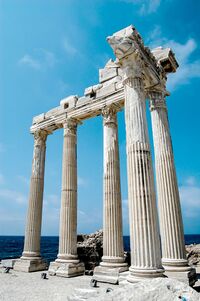Portal:Gentu/Article: Difference between revisions
Philimania (talk | contribs) No edit summary |
Philimania (talk | contribs) No edit summary |
||
| Line 1: | Line 1: | ||
<div style="float:left;margin:0.5em 0.9em 0.4em 0;">[[File: | <div style="float:left;margin:0.5em 0.9em 0.4em 0;">[[File:4fcfbc6fd10180caa9c957d4c15ffcb2--ancient-ruins-ancient-greek.jpg|200px]]</div>The '''Antiquity Era''', or simply '''The Antiquity''', is the period of history between the end of the [[Ancient Era]] with the [[Zestoric Meteor Strike]] in 550 BCE, and the fall of the [[Alarican Empire]] in 500 CE. The term Antiquity Era is not to be confused with the [[Ancient Era]], the Era that preceded the Antiquity Era. | ||
Divided in to the [[Early Antiquity|Early]], [[Middle Antiquity|Middle]], and [[Late Antiquity]], the era is characterised by the fall of the [[Calidum Empire]] in 364 BCE and the rise and [[Pylosan Golden Age|Golden Age]] of the [[Pylosan Empire]] in 496 BCE, the [[Zestoric War]] in 350 BCE, and the rise and fall of the [[Alarican Empire]] from 1 to 500 CE in [[Oranland]]. In [[Hesterath]], it is marked by the fall of the [[Cheng]] dynasty, and the beginning of the [[Warring States Period (Cheng)|Warring States Period]] in the [[Hesterath Lowland|Lowland]], and the emergence of the [[Jukso Culture]] in the [[Kharankhui Highlands]]. In the Domicas, the Antiquity is characterized by the abandonment of the [[Creek]] city-states, and in the [[Central Domica]]s, with the beginning of the [[Yectun Culture]]. ('''[[Flonesia|See more...]]''') | |||
Revision as of 10:55, 28 April 2022
The Antiquity Era, or simply The Antiquity, is the period of history between the end of the Ancient Era with the Zestoric Meteor Strike in 550 BCE, and the fall of the Alarican Empire in 500 CE. The term Antiquity Era is not to be confused with the Ancient Era, the Era that preceded the Antiquity Era.
Divided in to the Early, Middle, and Late Antiquity, the era is characterised by the fall of the Calidum Empire in 364 BCE and the rise and Golden Age of the Pylosan Empire in 496 BCE, the Zestoric War in 350 BCE, and the rise and fall of the Alarican Empire from 1 to 500 CE in Oranland. In Hesterath, it is marked by the fall of the Cheng dynasty, and the beginning of the Warring States Period in the Lowland, and the emergence of the Jukso Culture in the Kharankhui Highlands. In the Domicas, the Antiquity is characterized by the abandonment of the Creek city-states, and in the Central Domicas, with the beginning of the Yectun Culture. (See more...)
